University of San Carlos
|
Unibersidad sa San Carlos Pamantasan ng San Carlos Universidad de San Carlos | |
 | |
| Latin: Universitatis Sancti Caroli | |
| Motto | Scientia Virtus Devotio |
|---|---|
Motto in English |
|
| Type | Private research university |
| Established |
|
| Affiliation | Catholic |
| Chairman | Dr. Carmelita Quebengco, PhD |
| President | Rev. Fr. Dr. Dionisio M. Miranda, SVD, STD |
Academic staff | 2,500 |
| Students | 27,000+ (2016) |
| Undergraduates | 18,500 (2016) |
| Location | Cebu City, Cebu, Philippines |
| Campus | Urban; 5 campuses |
| Colors | Green and Gold |
| Nickname | Carolinians, USC Warriors |
| Website | www.usc.edu.ph |
The University of San Carlos (USC or colloquially shortened to San Carlos) is a private research and Catholic university in Cebu City which is administered and managed by the Society of the Divine Word since 1935. It offers a Montessori preparatory academy, Basic Education, 80 Undergraduate, and 85 Graduate programs, with a broad spectrum of academic disciplines through its 8 Schools and 27 Academic Departments.
USC has been considered as the de facto premier university in Cebu. It is ranked top five (5) nationwide and top one (1) in the Visayas and Mindanao with the most number of Centers of Excellence (8 COEs) and Centers of Development (12 CODs) awarded and recognized by the Commission on Higher Education (CHED) as of March 2016.[1][2] USC is also one of the top 8 leading universities in the country ranked by the International/World Quacquarelli Symonds (QS) Rating among the Top 350 Universities in Asia as of 2016 (USC is the lone Cebu based university and one of the 4 universities in the Visayas and Mindanao that were cited as among internationally recognized and world class universities in the Philippines; the other being Ateneo de Davao University, Silliman University and Xavier University – Ateneo de Cagayan).
USC's claims as the "oldest educational institution or school in Asia" has been a long time subject of disputes from the University of Sto. Tomas who on the other hand claims to be the "oldest university in Asia".
Campuses
USC consists of five campuses in different areas of Metro Cebu – the Downtown Campus (formerly the Main Campus) along P. del Rosario St.; the Talamban Campus (TC) along Gov. M. Cuenco Ave., Brgy. Talamban; the North Campus (formerly the Boys High Campus) along Gen. Maxilom Ave.; the South Campus (formerly the Girls High) along corners J. Alcantara St. (P. del Rosario Ext.) and V. Rama Avenue; and the newest is the Montessori Academy along F. Sotto Drive (at the back of USC North Campus).
History
According to the university's claim, San Carlos traces its roots to the Colegio de San Ildefonso founded by the Spanish Jesuits fathers Antonio Sedeno, Pedro Chirino and Antonio Pereira on August 1, 1595. It was closed in 1769 at the expulsion of the Jesuits. In 1783, the initiative of the Bishop Mateo Joaquin de Arevalo opened the Colegio-Seminario de San Carlos. In 1852, the management of the college was entrusted to the Dominican fathers, replaced in 1867 by the Vincentian Fathers then, in 1935, the Societas Verbi Divini or the Society of the Divine Word (SVD). The Second World War led to the interruption of the courses in 1941 because several buildings suffered various amounts of destruction. The buildings reopened as repairs were made over the course of 1945 and 1946. The Colegio de San Carlos (CSC) was granted its university charter in 1948. The University was named after St. Charles Borromeo.[3]
However, this position is contested by some scholars. According to Fr. Aloysius Cartagenas, a professor at the Seminario Mayor de San Carlos of Cebu, “following Church tradition, the foundation event and date of University of San Carlos should be the decree of Bishop Romualdo Jimeno on 15 May 1867 (turning over the seminary to the Congregation of the Missions) and the first day of classes in the history of what is now USC is 1 July 1867, the day P. Jose Casarramona welcomed the first lay students to attend classes at the Seminario de San Carlos.”[4][5] Thus, he says that San Carlos cannot claim to have descended from the Colegio de San Ildefonso founded by the Jesuits in 1595, despite taking over the latter’s facilities when the Jesuits were expelled by Spanish authorities in 1769. According to him there is “no visible and clear link” between Colegio de San Ildefonso and USC. San Carlos was specifically for the training of diocesan priests, and it simply took over the facility of the former, a Jesuit central house with an attached day school.
In 1924, San Carlos split into two under a Vatican decree that seminaries should only be for priestly training.[4][5] In the 1930s, the San Carlos college moved to a different location, P. Del Rosario Street, while the seminary remained at Martires Street. The Society of the Divine Word took over the college in 1935.[6]
The Second World War saw the closure and occupation of CSC by Japanese troops. Shortly before Liberation, in 1944, bombs from US planes fell on San Carlos, almost reducing the school to rubbles. San Carlos became a university in 1948, three years after it reopened. The seminary, meanwhile, was returned to diocesan control in 1998.[6]
Following Communist persecution of the foreign clergy in China in 1949, the University of San Carlos would benefit from the migration of SVD priest-scholars to the Philippines. This accidental émigré culture in USC spawned pioneering research in anthropology, physics, engineering, philosophy, and other fields, in the Philippines. This would have tremendous impact on the nation’s Post-War reconstruction.[6]
Rapid expansion of the University during the 1960s under the leadership of foreign priest-academicians came with the decade’s wave of militant nationalism, which culminated in calls for the Filipinization of the administration of all Catholic schools in the country. In 1970, Fr. Amante Castillo became the first Filipino president of USC.[6]
Academics
The academic and curricular programs below are offered by the different schools of the university, the following are :
- Basic education:
- Grade school (Kindergarten and Grades 1-6)
- Junior high school (Grades 7-10)
- Senior high school (Grades 11-12)
- Baccalaureate Programs:
- School of Architecture, Fine Arts and Design
- School of Arts and Sciences
- School of Business and Economics
- School of Education
- School of Engineering
- School of Health Care Professions
- School of Law and Governance
USC houses a Graduate School offering programs in School of Architecture, Fine Arts and Design, School of Liberal Arts and Sciences, School of Business and Economics, School of Education, School of Engineering, School of Health Care Professions, and School of Law and Governance.
University publications
Today's Carolinian
The official student publication of USC is Today's Carolinian (TC), which is run by its editorial board and staff composed of graduate and undergraduate students of the university. The official slogan of the publication is "Our Commitment. Your Paper." According to its website and Facebook page, the publication began as a re-established student publication of the University of San Carlos during the 80's, almost 10 years after Marcos' Martial Law seized the existence of student publications and other student institutions nationwide. It happened when the students launched its first strike against the administration to reinstate the student council and the student publication of the USC. The students were victorious in reinstating the Student Government. And then, the latter eventually brought back the student publication on September 1983 with Jose Eleazar Bersales as its transition Editor-in-Chief. With TC's incisive analysis on issues concerning the University and the country, not to mention its commitment to quality journalism, there was no doubt that TC became the premier student publication among the universities in Cebu. After some time in the early 2000s, the publication was shut down again and, with the efforts of the university's supreme student council, re-emerged in 2012.
USC Press
The USC Press is the official academic publishing house of the University of San Carlos. Since 1975 to present the university had published about 500 volumes of research journals and about 110 books of academic researches of the faculty, scholars, alumni and partners. The major research journals published are the Philippine Scientist a journal of natural sciences; Philippine Quarterly of Culture and Society a journal of humanities, arts, culture, history and social sciences; and research journals produced by different research centers and units of USC such as the Cebuano Studies Center, Kabilin Heritage Center, Water Resources Center, Office of Population Studies, Business Resource Center, and the different academic schools and departments of the university.
There are 35 books published by USC Press from 2008 to 2015 which cover and involve the following subjects and areas of interests : Historical Images of Cebu during colonial era; Religious Heritage of the Archdiocese of Cebu; Ancestral Houses and Heritage Sites of Cebu and Bohol; Cebuano Literature, Poetry, Language, Culture and Arts; Philippine Architecture (partnership with the University of Michigan); 75th years of SVD Mission at USC; Culinary Heritage of Cebu; Churches of Bohol before and after the 2013 Earthquake; 75th years of the USC College of Engineering; Battle of Cebu during the American Commonwealth era; Demographic and Socio-Economic Profile of Cebu based on 2010 Census; Birds of Cebu and Bohol; War in Cebu during the Japanese era of World War II and the History of Cebu province (consisting of 53 volumes for 3 independent cities, 6 component cities, 44 municipalities) which was commissioned by the provincial government of Cebu in 2008.
The USC Press published book “The Birds of Cebu and Bohol” won the prestigious 34th National Book Award in the Science Category for 2015 bestowed by the National Book Development Board (NBDB) and the Manila Critic’s Circle. The other two books published by USC Press : “The Battle for Cebu” and “Pagsulay: The Churhes of Bohol Before and After the 2013 Earthquake” were also awarded as Finalists in the History and Art categories respectively. USC Press joined the annual national competition of the NBDB in 2013.
Recognition
- Charter and Founding member of the Philippine Accrediting Association of Schools, Colleges and Universities (PAASCU), one of the first PAASCU accredited university in the country since 1961. USC School of Engineering is the first PAASCU accredited engineering school in 1974.[6] USC accreditation of PAASCU is Level III for 2015 to 2017.[6] Recently on September, 2015 the USC School of Engineering is the first engineering school in the Visayas and Mindanao to be granted international accreditation by the Philippine Technological Council (PTC) the authorized accrediting body in the Philippines of the Washington Accord. USC School of Engineering is one of the top 10 engineering schools in the Philippines accredited internationally with the PTC - Washington Accord as of 2015.[7][8]
- USC has been granted with an Autonomous status by the Commission on Higher Education (CHED) in 2001, 2005, 2009 up to present.[9]
- USC is awarded and recognized by the Commission on Higher Education (CHED) as a Center of Excellence (COE) in seven (8) academic programs namely : Anthropology, Business Administration, Chemical Engineering, Entrepreneurship, Mechanical Engineering, Office Administration, Physics and Teacher Education, being the top one (1) in the Visayas and Mindanao with the most number of COEs as of December, 2015.[1]
- USC is a Center of Development (COD) in Civil Engineering, Electrical Engineering, Electronics & Communications Engineering, Computer Engineering and Industrial Engineering, the only engineering school awarded and recognized by CHED as COD for the aforementioned engineering programs in Central Visayas. CHED awarded and recognized USCs Biology, Chemistry, Hotel & Restaurant Management, Information Technology, Marine Sciences, Philosophy and Tourism as CODs as well. Thus, USC is among the universities nationwide with the most number of Centers of excellence (8 COEs) and Centers of Development (12 CODs) awarded and recognized by CHED and top one (1) in the Visayas and Mindanao as of December, 2015.[1]
- The Professional Regulations Commission (PRC) ranked USC as one of the top performing schools for eight years 2008 to 2015 in the board exams for Accountancy, Chemical Engineering, Chemistry, Architecture, Pharmacy, Mechanical Engineering, among others.[10]
- The USC School of Law and Governance has been consistently in the Top Ten Law Schools in the Philippines (based on the Supreme Court Statistical Data), placing second to Ateneo de Manila University in the 2005 Bar Exams and 4th in the 2006 Bar exams (based on new candidates). Recently in 2015, the Legal Education Board awarded a Certificate of Excellence in Legal Education for being the top 4 nationwide and top 1 in Visayas and Mindanao school of law for maintaining one of the highest passing percentage and performance in the Bar exams in 2012, 2013 and 2014. The USC School of Law and Governance Moot Court Team is the first law school in the Visayas and Mindanao to win as champion of the nationwide Philippines Philip Jessup Moot Court Debate competition and represent the Philippines in the world's largest and most prestigious moot court debate the International Philip Jessup Moot Court Debate competition 2014 in Washington DC. USC moot court team made it to the finals top 10 and was awarded the best novice (new) team.[11]
- USC School of Law and Governance is the only law school in the Visayas and Mindanao to be granted license by the Supreme Court to have a Clinical Legal Education Program (CLEP), whereby its senior students are allowed to handle actual cases in the court with the assistance and under the guidance of a licensed member of the Bar. Likewise, it is the first law school outside Manila to be accredited by the Supreme Court to conduct Mandatory Continuing Legal Education (MCLE) seminar for lawyers.[12]
- The USC School of Engineering is the lone Philippine university member of the School on the Internet-Asia (SOI-Asia), a consortium of 15 universities situated in 11 countries across Asia. It can be noted that the Philippines was first connected to the Internet at the 1st International E- mail conference held at USC in March 1994.[13]
- The USC School of Business and Economics has been selected for the 2007/2008 EDUNIVERSAL 1,000 business schools that count on Earth by an International Scientific Committee. USC Accountancy program has consistently been among the top 3 highest passing percentage and performance in the Certified Public Accountants (CPA) board exam from 2012 to 2015. USC Accountancy clinched the top 1 performance with highest passing percentage with at least 50 exam takers and 5 board topnotchers in the May 2015 CPA board exam.[10]
- The university's Accountancy, Architecture, Chemical Engineering, Chemistry, Law, Mechanical Engineering and Pharmacy programs are regarded as one of the best in the country, consistently among top performing school and producing board and bar exam topnotchers.[10]
- USC has been noted as among leading universities in the country with long tradition and track record of Research and Publications. Among its Research Centers are the USC Museum, Cebuano Studies Center, Kabilin Heritage Center, Office of Population Studies, Business Resource Center, "Kapamilya Negosyo Na" (KNN) Center (joint project with ABS-CBN), Business & Economics Center for Information & Communications Technology (CICT), Center for Legal Aid Work (CLAW), San Carlos Publications and the USC Press which are located in Downtown and Talamban campuses, Cebu City.[6]
- USC academic excellence and research leadership in the Sciences and Technology is evidenced with the various Research Centers and Laboratories located in the Talamban campus, Cebu City namely: Water Resources Center, Water Analysis & Testing Laboratory, Bio-Process Engineering Research Center, Chemical, Environmental & Analytical Instrumentation Research Laboratory, Microelectronics & Robotics Laboratory, Computer Engineering PCB Prototyping & Fabrication Laboratory, Mechanical Engineering CAD/CAE/CAM & CNC Machine Tool Laboratory, Calibration, Repair & Maintenance Laboratory, Civil Engineering Hydrology & Soils Engineering Laboratory, Materials Testing Laboratory, Computer Science / Information Technology Software Development Laboratory, Applied Physics, Bio-Medical Physics and Nano-Physics & Chemistry Research Laboratory, Natural Products Chemistry Research Laboratory, Molecular Biology Research Laboratory, Biological & Entomological Collections Museum, Marine Collections Museum, Botanical Garden and Nature Park, Non Conventional & Renewable Energy Research Laboratory, Power Plant & Hydraulics Engineering Laboratory and the Ambient Air Quality & Pollution Monitoring Station (joint project with the DENR-EMB Region 7). There are two (2) Marine Biology Research Stations which are located in Liloan and Mactan island,Cebu. The School of Architecture, Fine Arts & Design has specialized Multimedia & Graphic Design Laboratory, Urban Planning & Development and Landscape Architecture Research and a Performing Arts Theater. In 2012, USC inaugurated one of the country's biggest and largest University Central Library and Learning Resource Center at the Talamban campus. Infrastructure development of USC Talamban campus is being undertaken continuously with the expansion and building of access roads within the campus, underground cabling of utilities and communication lines and construction finishing works of the new University Stadium which will be one of the largest in the country. In the next 5 to 10 years extensive development projects will be pursued to develop the USC Talamban campus as a Univer-City one of the first among the universities in the country.
- USC Bio-Process Engineering Research Center (BioPERC) of the Chemical Engineering (ChE) department research and development (R&D) project on the re-use and re-utilization through biochemical processing of bio-organic wastes from processed mangoes and other tropical fruits into high value-added, healthy and anti-oxidant rich flour, fine poly-organic chemicals and activated carbon, is recognized by the World Intellectual Property Organization (WIPO) and Asia Pacific Economic Cooperation (APEC) as the "First Success Story" of an Intellectual Property (IP) technology innovation and commercialization from the academe in the Philippines. The technology developed was patented with the technical and administrative assistance of the Intellectual Property Office of the Philippines (IPOPHIL) and the USC Innovation & Technology Support Office (ITCO). The project catalyzed the inception of a new start-up company the Green Enviro Management Systems, Inc. (GEMS) which inaugurated and commenced full operation of its processing plant facilities in Mandaue City. This technology and innovation start-up company GEMS endeavors to help the environment by re-use and re-utilization of mango or tropical fruits wastes, promote healthy, gluten free, rich in anti-oxidants and fiber flour and provide decent jobs and income to poor marginalized informal settlers in the dump sites.[14]
Notable alumni
See also
Gallery
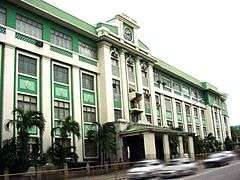 Old facade of the main building in USC - Downtown Campus
Old facade of the main building in USC - Downtown Campus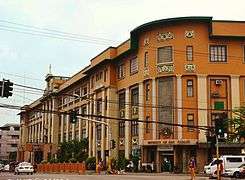 Current facade of the main building in USC - Downtown Campus
Current facade of the main building in USC - Downtown Campus- Inside view of the new main building at Downtown Campus
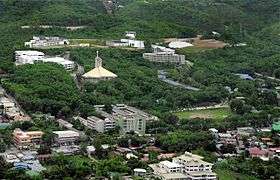 Aerial view of USC - Talamban Campus
Aerial view of USC - Talamban Campus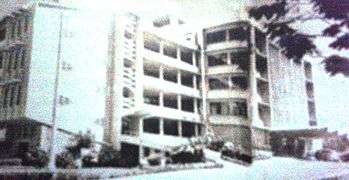 Facade of the Fr. Bunzel Building which houses the USC School of Engineering at Talamban Campus
Facade of the Fr. Bunzel Building which houses the USC School of Engineering at Talamban Campus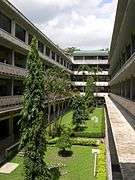 Inside view of the Fr. Bunzel Building at Talamban Campus
Inside view of the Fr. Bunzel Building at Talamban Campus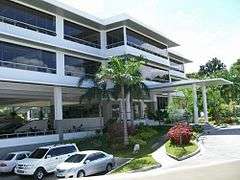 USC School of Architecture, Fine Arts & Design building at Talamban Campus
USC School of Architecture, Fine Arts & Design building at Talamban Campus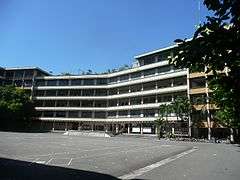 USC School of Education building at the South Campus
USC School of Education building at the South Campus
External links
- Official website
- Today's Carolinian on Facebook (USC's Official Student Publication)
- USC Supreme Student Council on Facebook
- USC Blogspot
References
- 1 2 3 CMO 37 series of 2015 : Extension of designation of Higher Education Institutions (HEIs) granted as Centers of Excellence and Centers of Development in Teacher Education and Engineering Programs of Civil Engineering, Electrical Engineering, Electronics & Communications Engineering, Industrial Engineering and Mechanical Engineering until March 30, 2016.
- ↑ CMO 38 series of 2015 : Designated Centers of Excellence and Centers of Development for Various Disciplines Effective January, 2016 to December, 2018.
- ↑ About USC – University of San Carlos. Usc.edu.ph. Retrieved on 2012-04-24.
- 1 2 http://opinion.inquirer.net/inquireropinion/columns/view/20110127-316853/No-contest-UST-is-oldest-university. No contest: UST is oldest.
- 1 2 http://www.varsitarian.net/news/20110126/ust_is_oldest_period. UST is oldest, period.
- 1 2 3 4 5 6 7 http://usc.edu.ph/about-usc/brief-history/
- ↑ Engineering Accreditation : Philippine Technological Council (PTC)
- ↑ Washington-Accord : International Engineering Alliance / Washington Accord
- ↑ CMO 18 series of 2012 :Updated List of Private Higher Education Institutions (HEIs) granted Autonomous and Deregulated Status
- 1 2 3 board examination / performance of schools : Professional Regulatory Commission (PRC) Performance of Schools in Board Examinations 2012 to 2015
- ↑ Cebu law students to compete in D.C.
- ↑ Mandatory Continuing Legal Education
- ↑ Philippine Internet Timeline
- ↑ Commercializing IP: changing academic mindsets in the Philippines
Coordinates: 10°17′58″N 123°53′56″E / 10.29944°N 123.89889°E